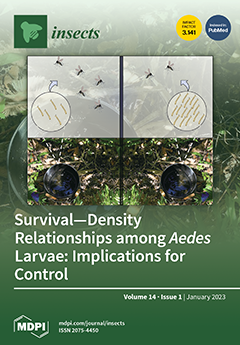Phoracantha semipunctata is a destructive invasive alien forest pest worldwide. It primarily damages the eucalyptus via adults, affecting almost all parts of the eucalyptus. Its larvae develop in almost all major tissues of the plant.
Phoracantha semipunctata spreads both via the migration of
[...] Read more.
Phoracantha semipunctata is a destructive invasive alien forest pest worldwide. It primarily damages the eucalyptus via adults, affecting almost all parts of the eucalyptus. Its larvae develop in almost all major tissues of the plant.
Phoracantha semipunctata spreads both via the migration of adults and global trade in intercontinental translocation. Currently, this pest has spread to six continents worldwide, except Antarctica, resulting in substantial economic losses. Based on global occurrence data and environmental variables, the potential global geographical distribution of
P. semipunctata was predicted using an ensemble model. The centroid shift, overlap, unfilling, and expansion scheme were selected to assess niche dynamics during the global invasion process. Our results indicated that the AUC and TSS values of the ensemble model were 0.993 and 0.917, respectively, indicating the high prediction accuracy of the model. The distribution pattern of
P. semipunctata is primarily attributed to the temperature seasonality (bio4), mean temperature of the warmest quarter (bio10), and human influence index variables. The potential geographical distribution of
P. semipunctata is primarily in western and southwestern Asia, western Europe, western and southern North America, southern South America, southern Africa, and eastern and southern Oceania. The potential geographical distribution of
P. semipunctata showed a downward trend in the 2030s and the 2050s. The distribution centroid showed a general tendency to shift southward from the near-current to future climate.
Phoracantha semipunctata has largely conserved its niche during the global invasion process. More attention should be paid to the early warning, prevention, and control of
P. semipunctata in the countries and regions where it has not yet become invasive.
Full article






